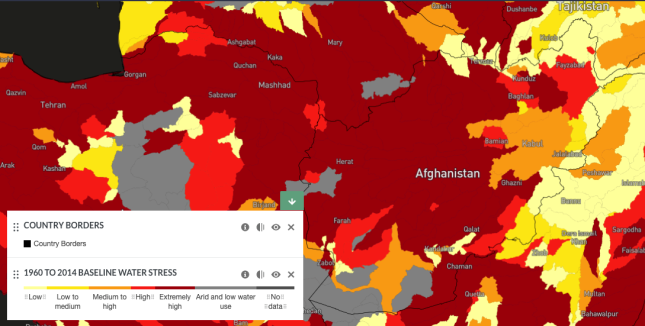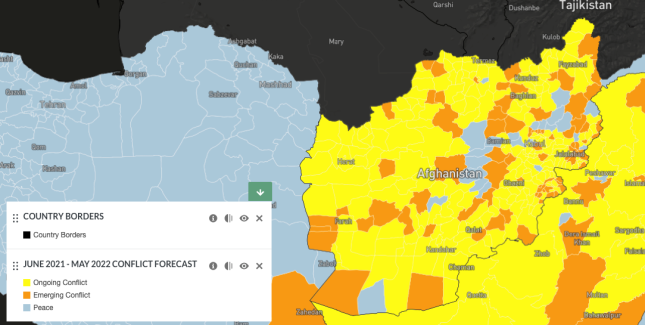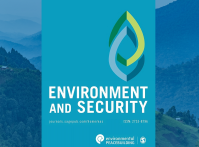-
Water and (in-)Security in Afghanistan as the Taliban Take Over
August 20, 2021 By The Water, Peace and Security (WPS) Team
The takeover of Afghanistan by the Taliban not only threatens people’s lives, security, and fundamental freedom, but also significantly increases risks of water insecurity both immediately and in the long term. While our hearts and minds are with the people struggling for survival and freedom in Afghanistan today, we should not forget that the implications of Taliban rule will add yet another challenge to the long-term future of the Afghan people, and possibly also to the entire region’s stability.
The Water Situation in Afghanistan is Dire
Years of war and instability have affected the Afghan water sector. While the country has a relatively favorable water endowment and enjoys a prime upstream location on the rivers it shares with neighboring countries, its crumbling water sector and severe shortcomings in water resources management leave the country in a horrible state of water stress (see Figure 1 of Baseline Water Stress in Afghanistan below). This scarcity continues despite the efforts to rebuild the country, including its water sector, over the past 20 years. More than 70 percent of the population lacks access to safe drinking water, with available drinking water often contaminated. Demand continues to grow, especially in urban areas, and rampant internal displacement due to the recent Taliban advances will only worsen this situation over the coming months.
Continuous water shortages due to water mismanagement, combined with the effects of climate change, have also affected the agricultural sector and food security in the country. Accounting for 90 percent of the country’s water use and 80 percent of the population’s employment, the agricultural sector is unable to provide sufficient food for Afghanistan’s population, partly due to water shortages. One-third of the Afghan population suffers from acute food insecurity and this is only expected to increase as the increasing instability effects agricultural production.
Immediate and more long-term humanitarian crises are likely to arise, as well—especially if international donors and aid organizations stop their emergency relief and support due to political reasons or simply because engaging on the ground becomes too dangerous.
Ongoing Water Insecurity
Persistent water insecurity is one of a number of factors that has played a crucial role in Taliban recruitment. In areas of poor water security, young men deprived of economic opportunities due to declining agricultural opportunities often see joining the Taliban as the only way to provide for their families.
In addition, the government’s inability to effectively address water and food insecurity has contributed to its de-legitimization, allowing the Taliban to present itself as a legitimate alternative.
At the local level, the Taliban has taken advantage of mirabs—local informal water management institutions that have, for centuries, allowed for a relatively peaceful allocation of often scarce water among farmers. The mirabs were widely supported by the previous government under President Ghani and the Western donor community in the context of Afghanistan’s water sector reform. But in areas under their control, the Taliban have pushed the mirabs towards the cultivation of poppy, illegal under Afghan law. And they have—often by force—shifted water allocation towards poppy, which has not only reduced the production of food crops in these areas, but also undermined the functioning of the mirabs, with poppy income and power interests prevailing over the most effective allocation of scare water.
In combination with drought conditions, this left farmers with limited cropping choices, increasing food insecurity and pushing them closer and closer to illicit groups. Afghanistan is already the world’s number one opium producer, contributing more than 90 percent of the world’s illicit heroin and more than 95 percent of the European supply. The likely expansion of this under the Taliban will lead to a further surge in the global heroin trade and may consolidate Afghanistan’s (and the region’s) position as a drug trafficking hub. While growing poppy can earn the Taliban a considerable profit, it will not feed the Afghan people.
Water Management Challenges
The Taliban’s takeover signals a continuation of water management challenges related to Taliban strategies in the past. While the Taliban have been using water governance arrangements in their favor and seem to be well aware of the role that water resources play in people’s lives and livelihoods, they have also shown that they lack the ability and the willingness to manage those resources in favor of the population. But as their position in the country changes, so does their accountability for water-related challenges. Rather than of playing the role of disrupters, they will be facing the consequences of the country’s dire water situation. Below, we extrapolate what Taliban water policy may look like, based on their past takeover.
First, all advances in attempting to reform and strengthen water resources governance in Afghanistan—albeit of limited effectiveness—will likely be reversed. This includes promising attempts such as the revision of the country’s water law in 2009 and the development of river basin management plans for the country’s main basins, based on improved data and analyses supported by the international community. Steps were also undertaken to support more equitable rights for women, including access to water and sanitation. It remains to be seen how Sharia law—which includes provisions on the use of water resources—will be able to govern the complex water challenges of the country. It seems clear, however, that the sole reliance on traditional governance arrangements will be insufficient to address the problems of water allocation, water over-abstraction, and water pollution in the country—let alone the consequences of climate change.
Drought-related food insecurity has already been a key driver of mass internal displacement. In 2018 alone, 22 out of 34 Afghan provinces were hit by drought, forcing more than 300,000 people to move internally for food insecurity reasons. Food insecurity, combined with the Taliban’s inability to effectively govern water resources in all parts of the country due to a relatively small number of officials and even fewer well-trained ones, could lay the groundwork for new local conflicts over water resources (adding to existing conflict, as shown in Figure 2.)
The takeover by the Taliban also implies a further reduction of technical capacity in water management. There is little to no expertise among their ranks when it comes to managing water resources, operating water infrastructure, or organizing water allocation at various governance levels. Experts from all levels of the previous government are trying to leave the country or are no longer able to work. As a result, the Taliban will continue to struggle to find such expertise to maintain—let alone develop—water resources management in the country, unless done so by force. This seems to be happening in parts of the country, where Taliban fighters are forcing government officials to remain in technical positions to ensure basic services. Further, the Taliban’s stance on key modern technologies suggests that the tools and instruments for addressing water insecurity, especially in the context of climate change, will not be made available. It remains to be seen whether any assumption that the Taliban might have reversed their strictest stances on modern technology in order to cement their power is actually true.
These capacity challenges will affect water resources management through qanat or karez (a traditional canal system for irrigation) as well as the mitigation of conflicts among different water users at the local level. When the Taliban took over control of Dahla Dam in Kandahar Province in May 2021, the government withdrew irrigation experts that were managing the dam. Those experts did not return to the dam, even after they were asked to return by the Taliban to ensure water flows to farmers. This left flows from the reservoir interrupted, threatening crops during the main growing season. Capacity challenges will also affect the relations between Afghan provinces that already compete for water, which may escalate as governance deteriorates and people’s needs rise.
Water as a Weapon
Another worrisome development is the Taliban’s repeated use of water (and water infrastructure) as a weapon, which can be expected to continue if civil war unfolds. For instance, in May 2021, the Taliban cut water to more than 800 families in the Badakhshan District during their advances in the region. Taliban policies have also targeted dams as symbolic objects of water infrastructure. During the same time period, the Taliban took control of Dahla Dam in Kandahar Province. And in their advances towards Herat, they attacked the Afghanistan-India Friendship Dam, the main provider of water—especially for irrigation—and power for hundreds of thousands of people in Western Afghanistan, with considerable casualties and some attacks hitting the dam itself, most likely leaving major damage to the structure.
Likewise, their ability to respond to water-related disasters is minimal. During recent flooding in the Nuristan Province at the end of July 2021, the Taliban denied government staff access to areas devastated by flash floods, which killed more than 150 people and left houses and property damaged. They did not provide emergency relief, leaving people in despair.
All of this comes at a time when most of Afghanistan has been suffering through a serious drought, severely affecting people’s food security and mere survival. These consequences will also contribute to migration flows out of Afghanistan, as even those whose lives are not directly at risk of Taliban violence see no other option for survival beyond leaving their homes for other areas, either within the country or across borders. This has the potential to put additional strain on countries already struggling with an influx of Afghan migrants. In 2020, Afghanistan was the second largest source of irregular migrants to Europe via the Western Balkan route, with numbers likely to increase due to Taliban takeover.
Water Insecurity in Neighboring Countries
Water insecurity and imminent Taliban rule also present significant challenges to Afghanistan’s neighboring countries, especially Iran. Both the Harirud and the Helmand Rivers flow from Afghanistan into Iran. Iran has always opposed the construction of Afghan dams, due to fear of reduced water flows into Iran. There have even been claims that Iran has supported the Taliban’s attacks against dams. However, the Taliban’s supervision over these dams could also have disastrous consequences for downstream Iran if continued violence or lack of maintenance results in dam failure.
In January 2021, the Taliban and Iranian governments made arrangements ensuring Iranian access to water from shared rivers, in case the Taliban gained control over these areas. Around the same time, the Iranian government also pursued similar negotiations with the Afghan government to secure water flows from Afghanistan, leading to an arrangement on the basis of the earlier 1973 Helmand Treaty. In March 2021, then Afghan President Ghani declared that Afghanistan would not continue to provide water for free, but would require oil in exchange for the Helmand River’s flows. It remains to be seen how Iran will react to any changes the Taliban implements to the flow of water to Iran, but there is potential for political tensions to be further complicated.
Afghanistan’s Water Future
It is clear that the takeover by the Taliban will significantly challenge the water and food security of the country’s population. These insecurities increase the likelihood of water-related conflicts, adding to the already extremely fragile situation in the country, and intensify the risk of tensions with neighboring states over shared water resources. Moreover, a further deterioration of the already inefficient and ill-functioning water sector will have long-term implications that span far beyond the current Taliban’s rule.
The future of Afghanistan is highly uncertain. Immediate help to the Afghan people, especially those particularly vulnerable to the Taliban, is essential. And while focusing efforts on protecting the lives of Afghans who are most threatened by recent events is of utmost importance, water insecurity and its ties to conflict should not be ignored by the international community.
The Water, Peace and Security (WPS) partnership was established in 2018 to enable public, private and civil society actors to timely and effectively address the threat of water-induced conflict and harvest the benefits of water-based cooperation and peacebuilding. Supported by the Netherlands Ministry of Foreign Affairs and the Gesellschaft für internationale Zusammenarbeit (GIZ), it brings together research institutes, environmental and peacebuilding organizations: IHE Delft (lead), Deltares, The Hague Centre for Strategic Studies, International Alert, Wetlands International, the World Resources Institute, and Oregon State University.
Sources: Afghanistan Times, Al Jazeera, Atlantic Council, Climate Diplomacy, CTV News, International Centre for Integrated Mountain Development, International Centre for Migration Policy Development, International Crisis Group, International Journal of Educational Studies, Johns Hopkins University, Reuters, Salaam Times, Tehran Times, The Conversation, The Iran Primer, The Khaama Press News Agency, TOLOnews, UNICEF, United Nations, United Nations Assistance Mission in Afghanistan, United Nations Office on Drugs and Crime, United Nations Water, United Nations World Food Programme, Water International, Water, Peace and Security Partnership, World Bank, World Resources Institute.
Photo Credit: Women carrying water in Kabul, Afghanistan, courtesy of timsimages.uk, Shutterstock.com.
 A Publication of the Stimson Center.
A Publication of the Stimson Center.









